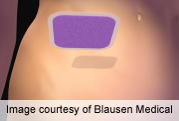
THURSDAY, March 29 (HealthDay News) — Researchers say they’re designing patch-like devices to wirelessly transmit information about a person’s vital health statistics, potentially freeing patients from the wires and sticky electrodes of electroencephalograms (EEGs) and electrocardiogram (EKGs).
The devices, currently envisioned to be more like a temporary tattoo than a medical patch, could conceivably measure heart activity and brain waves, said John Rogers, a professor of materials science and engineering at the University of Illinois at Urbana-Champaign, who spoke about the new research at a conference this week.
“The big benefit would be the ability to continuously monitor health and wellness,” Rogers said. “There’s a lot of interest in personalized medicine and the quantified self, and hardware is key.”
The research, however, is in the preliminary stages. It’s not clear how much the devices would cost or how long it will take before they could be available. However, Rogers and colleagues have formed a company to bring the devices to the medical market.
The goal is to figure out how to measure something that the body is doing — the actions of the heart, for instance — and then transmit the information without the use of wires. The researchers also want to make devices that are more like tattoos, which closely follow the contours of the skin, than medical patches, which are more rigid and can irritate the skin, Rogers said.
The researchers think their devices “will bear a lot of similarities to kids’ temporary transfer tattoos,” he said. “That’s the mental picture that you should have. Once it’s on you, you don’t know it’s there anymore.”
The patches in development are about an inch square, roughly the size of a stamp, he said. The plan is to install a transmission system that allows the patches to send out information wirelessly, a bit like the so-called RFID devices that set off alarms when customers leave stores without buying their merchandise.
The researchers are still putting all the parts together to build the devices.
They’re experimenting with ways to make the devices stick to the skin and protect them from water, and they’re exploring ways to send signals back and forth. That way, for example, a device could send information about the way that muscles are moving and send back instructions about stimulating the muscles.
There’s even talk about putting the devices on internal medical equipment like the catheters used in heart surgery, allowing doctors to monitor how the procedures are progressing.
Another possible application is to use the devices to measure the hydration of the skin, potentially giving people the opportunity to figure out if their moisturizer is working properly. “It might go on your cheek for 10 seconds, and you get measurements of what’s gong on with your skin and determines the kind of cream you might want to use,” Brown said. “In that case, you want a device that’s fully soft and skin-like. No one’s going to put a full wire probe on their face.”
Gordana Vunjak-Novakovic, vice-chair of the department of biomedical engineering at Columbia University, in New York City, said it’s too early to comment in depth on the research. Still, “I look forward to learning about details,” she said. “The potential for this kind of technology is huge, and I am sure that the initial applications we can envision at this time will lead to the new ones. In particular, the combination of soft materials, wireless technologies and micro devices may bring measurements — and interventions — in the whole (body) to an entirely new level.”
A report about the development of the patch-like device was scheduled for release Monday at a meeting of the American Chemical Society in San Diego. With research presented at medical meetings, the data and conclusions should be viewed as preliminary until published in a peer-reviewed journal.
More information
For more about medical patches, try the U.S. National Library of Medicine.

